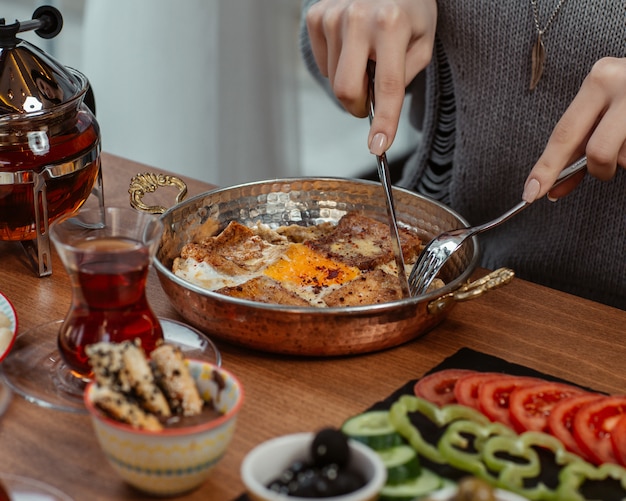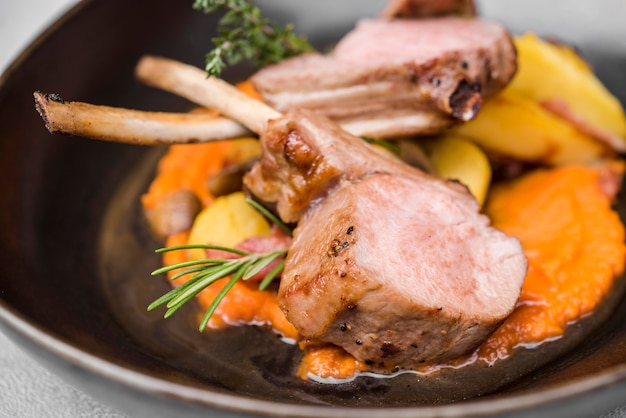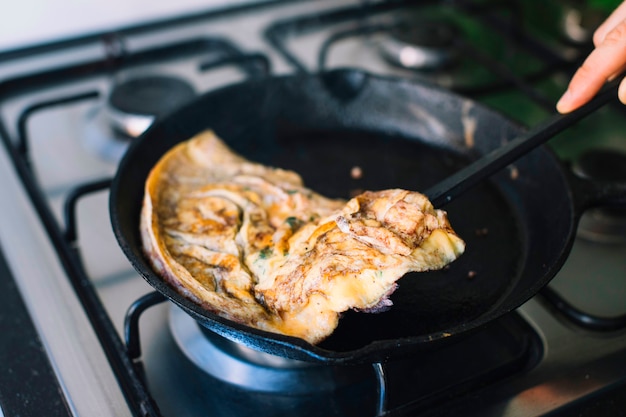Let's talk filet mignon. You know, those glorious little medallions of beef that make you feel like you're dining in a fancy restaurant? I've cooked my share of filets over the years, and there's nothing quite like the feeling of a perfectly seared, juicy, tender steak. But I also know that many people are intimidated by cooking this type of meat. They think it's some fancy, high-maintenance dish, best left to the professionals.
Well, I'm here to tell you that's a load of hooey! Cooking a perfect filet mignon on the stovetop is actually super easy. It just takes a few key tips and a bit of practice. This is the guide I wish I had when I first started out, so I'm going to break it down step-by-step, from choosing the right cut to serving it up beautifully. So, grab your trusty pan and let's get cooking!
Part 1: Choosing Your Filet Mignon

Right off the bat, let's talk about the meat. Choosing a good filet mignon is like finding a diamond in the rough. You need to know what you're looking for, and it doesn't hurt to have a good butcher on your side!
The Cut
First things first: the cut. You want a nice, thick piece of beef, ideally a "center cut" filet. It's usually the most tender part of the whole tenderloin. This is the heart of the beast, and it's where you'll find the most succulent and flavourful meat. Now, you'll see different grades like Prime, Choice, and Select. I'm a bit of a Prime fanatic. It's the highest grade, meaning it's got the best marbling, and that's what makes the steak super juicy and flavorful.
Marbling
Speaking of marbling, that's another crucial factor. It's those little streaks of fat that run through the meat. The more marbling, the richer and more tender your steak will be. Now, don't be afraid of the fat! It renders down as it cooks, giving the meat its beautiful flavour. The fat actually melts and basted the meat as it cooks, resulting in a deliciously juicy and flavourful experience.
Thickness
And last but not least, consider the thickness. You want a filet mignon that's at least 1 inch thick, but 1.5 inches is ideal. It'll help ensure that the steak cooks evenly and doesn't dry out too much. This is especially important if you're a bit of a beginner. A thicker piece gives you a little more room for error, making it easier to get the perfect level of doneness.
Part 2: Preparing Your Filet Mignon

Once you've got your perfect piece of beef, it's time to get prepped. This is where you'll get that lovely crust and create a delicious, juicy interior.
Patting It Dry
The first step is to pat your filet mignon dry with paper towels. This will help create a crispy crust when you sear it later. It's all about maximizing surface contact with the hot pan, resulting in a beautiful crust.
Seasoning
Now, here's where you can have a bit of fun. I like to keep things simple and just season my filet with salt and pepper. You can even use a good quality sea salt. It's that beautiful contrast of saltiness and peppery spice that really brings out the flavor of the meat. If you're feeling adventurous, you can add some other spices like garlic powder, onion powder, or a dash of paprika. Don't forget, the simpler the flavouring, the more you can taste the quality of the steak!
Resting
The next step is crucial: letting the steak rest at room temperature for about 30 minutes. This will allow the meat to come to a more even temperature, which will help it cook more evenly. It might seem counterintuitive, but trust me, it makes a big difference! You'll get a more consistent cook throughout the steak, resulting in a perfectly cooked filet mignon from edge to center.
Part 3: Searing Your Filet Mignon

Okay, now for the fun part! It's time to sear that beautiful filet and make it the star of the show.
Get Your Pan Hot
First things first, get your pan nice and hot. We're talking screaming hot here! I use a cast iron skillet, but any heavy-bottomed pan will do. I like to heat it up over high heat for about 5 minutes, until it’s just about ready to smoke. It should be so hot that a drop of water will sizzle and evaporate immediately.
The Oil
Now, add your oil. I use a good quality olive oil, but you can use vegetable oil or even avocado oil if you prefer. Just a tablespoon or two will do.
Searing Time
Now, gently place the filet mignon in the hot pan. Don't overcrowd the pan, you want to give it some space to cook evenly. Let it sear for 3-4 minutes per side, without moving it around too much. You want a nice, crispy crust. You can use a meat thermometer to check the temperature. It’s a good habit to get into, so you don’t overcook! You’re aiming for 130-135°F (54-57°C) for medium-rare.
Don't Forget the Edges
Once you've seared the sides, don't forget the edges! Give those a quick sear for another minute or two to really lock in all the flavor. This ensures that you get a beautiful, caramelized crust all the way around the steak.
Part 4: Finishing Your Filet Mignon
The steak is looking gorgeous, with that beautiful, caramelized crust. Now it’s time to finish it off to perfection.
The Oven Finish
If you want a perfectly cooked filet mignon, the oven is your best friend. After the sear, transfer the steak to a preheated oven (350°F/175°C). This helps cook it through to your desired level of doneness without overcooking the outside. It's a gentle, consistent heat that ensures the steak cooks evenly without getting tough.
The Rest
Once the steak is cooked to your liking, take it out of the oven and let it rest for 10-15 minutes. This allows the juices to redistribute, making it even more tender and juicy. The steak will continue to cook slightly as it rests, ensuring that it reaches your desired temperature.
Don’t Forget the Pan Sauce
Now, remember all that deliciousness that’s been sizzling in your pan? That's called fond, and it's the foundation for a fantastic pan sauce. Those little caramelized bits are pure flavour, so don’t waste them!
Part 5: Making a Simple Pan Sauce
Time to turn those leftover bits and bobs into something spectacular.
Deglazing the Pan
The first step is to deglaze the pan. This means adding a bit of liquid (like wine or stock) and scraping up all the delicious bits stuck to the bottom. The liquid helps dissolve those caramelized bits, turning them into a delicious sauce.
Reducing the Sauce
Next, reduce the sauce over medium heat, letting it simmer and thicken until it's nice and glossy. You want to simmer it until it's slightly thickened and has a rich, concentrated flavour.
Flavouring
You can add some flavour to your sauce by adding things like Dijon mustard, fresh herbs, or a squeeze of lemon. I like to keep it simple with a splash of red wine and a little bit of butter. It’s a classic for a reason! The red wine adds depth of flavour, and the butter gives it a lovely sheen and richness.
Part 6: Serving Your Filet Mignon
Now for the grand finale! It’s time to plate up this masterpiece.
Plating Up
Slice the steak into medallions, and arrange them on a plate. I like to use a beautiful white plate to showcase the beautiful colour of the meat. The contrast of the white plate makes the steak stand out even more.
Garnish
Add a dollop of your pan sauce, and then add a sprinkle of fresh herbs for that final touch of elegance. You can also use other garnishes like roasted vegetables or a drizzle of balsamic glaze. A little sprinkle of parsley or chives adds a touch of colour and freshness.
Enjoy!
It's finally time to dig in. Take a bite and savour every delicious morsel of that perfectly cooked, juicy steak. This is the moment you've been waiting for!
Part 7: Tips for a Perfect Filet Mignon
So, you're ready to conquer the filet mignon? I’ve got a few more tips to make it even easier.
Use a Meat Thermometer
A meat thermometer is your best friend when it comes to cooking steak. It takes the guesswork out of it and ensures that you don't overcook your meat. Insert the thermometer into the thickest part of the steak, avoiding any bone or fat.
Don't Overcook
It’s a common misconception that filet mignon needs to be cooked well-done. The beauty of this cut is in its tenderness and juiciness. You want to cook it to your desired level of doneness, but don't overdo it!
Rest, Rest, Rest
You can never rest your steak enough. Let it rest for at least 10 minutes before slicing and serving to allow the juices to redistribute. This is a crucial step for achieving a tender and juicy steak.
Don't Be Afraid to Experiment
Filet mignon is a blank canvas. Feel free to experiment with different seasonings and sauces to find your perfect combination. Try different herbs and spices, or even a touch of sweetness with a drizzle of honey.
Get a Good Butcher
If you're unsure about choosing a good piece of filet mignon, don't hesitate to ask your local butcher for advice. They’re usually a great source of information, and they can even help you cut the meat to your desired thickness. They'll know the best cuts and can help you get the perfect piece for your cooking needs.
Part 8: FAQs
Let's tackle some common questions about filet mignon.
Q1: What's the difference between filet mignon and tenderloin?
A: Filet mignon is actually just a small, thick, and tender cut taken from the center of the beef tenderloin. The entire tenderloin is a long, cylindrical muscle, while filet mignon is a specific section that's often sliced into medallions.
Q2: What are the different levels of doneness for filet mignon?
A: The most common levels of doneness for steak are:
| Doneness | internal temperature |
|---|---|
| Rare | 125-130°F (52-54°C) |
| Medium-Rare | 130-135°F (54-57°C) |
| Medium | 140-145°F (60-63°C) |
| Medium-Well | 150-155°F (65-68°C) |
| Well-Done | 160°F (71°C) and above |
Q3: How long should I let my filet mignon rest?
A: You should let your filet mignon rest for at least 10 minutes before slicing and serving. This will allow the juices to redistribute, making the steak even more tender and juicy. It's important to let the steak rest for the juices to redistribute and prevent the steak from drying out when slicing.
Q4: What can I serve with my filet mignon?
A: There are countless delicious options for serving with your filet mignon. Some popular choices include:
- Roasted vegetables (like asparagus, broccoli, or Brussels sprouts)
- Creamy mashed potatoes
- green beans
- Risotto
- Pasta
- Salad
Q5: Can I cook filet mignon on the grill?
A: Absolutely! Grilling is a fantastic way to cook filet mignon. Just make sure your grill is nice and hot and that the grates are clean. For best results, use a gas grill or a charcoal grill with a consistent heat source.
There you have it! A simple, straightforward guide to cooking a delicious filet mignon on the stovetop. Now you can impress your guests with a restaurant-quality steak without even leaving the kitchen. So, get your apron on, grab your favorite spices, and get ready to cook! Happy eating!
Everyone is watching

How to Cook Frozen Lobster Tails Perfectly: A Step-by-Step Guide
RecipesLobster. Just the word conjures up images of lavish meals, special occasions, and a taste of luxury. But let's...

Pigs in a Blanket Cooking Time: How Long to Bake for Perfect Results
RecipesAh, pigs in a blanket. Just the name conjures up images of those delightful little parcels of crispy pastry en...

Pork Fillet Cooking Time: How Long to Cook It Perfectly
RecipesPork fillet, or tenderloin as it's sometimes called, is a real favourite in our house. It's so versatile, and...

The Ultimate Guide to Tender, Juicy Pulled Pork
RecipesRight, let's talk pulled pork. It's one of those dishes that just screams "comfort food," doesn't it? I mean...

The Ultimate Guide to Cooking Sweet Potatoes: From Roasting to Mashing
RecipesSweet potatoes. Just the name conjures up images of warm, comforting dishes, bursts of vibrant color, and a to...
